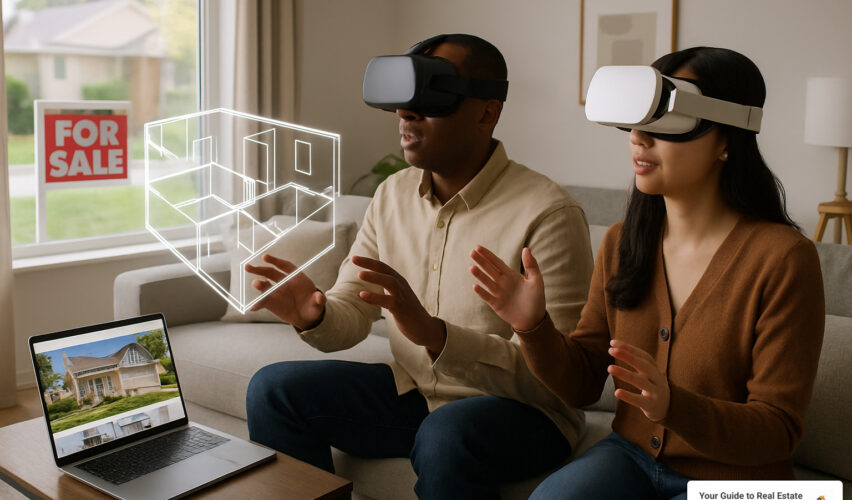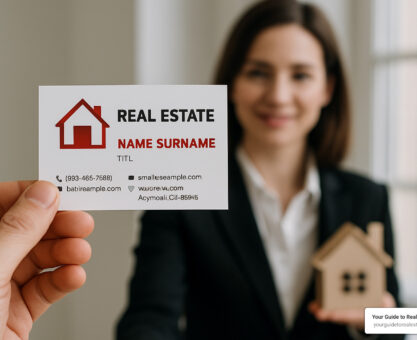Changing Home Shopping: The Power of Virtual Reality Home Tours
Virtual reality home tours are immersive 3D experiences that allow potential buyers to explore properties remotely, moving through each room as if physically present. These digital tours have revolutionized the real estate industry, particularly as more homebuyers begin their search online.
What are virtual reality home tours?
- Definition: Interactive 3D digital recreations of properties that allow remote viewing
- Technology: Created using specialized 360° cameras placed throughout a home
- Access: Viewable on smartphones, computers, or VR headsets without special software
- Features: Self-guided navigation, dollhouse views, interactive floor plans
- Benefits: 24/7 property access, pre-screening before in-person visits, global reach
The statistics speak volumes about the impact of this technology. According to recent data, listings with interactive floor plans and virtual tours receive 72% more shares, 60% more views, and are saved 79% more often than traditional listings. With 92% of homebuyers beginning their search online, these immersive experiences have become a critical first impression.
“Our 360° 3D virtual tours are the most realistic and immersive way to experience properties online,” notes one real estate professional. Unlike traditional photo galleries or videos, VR tours give buyers control over their viewing experience, allowing them to linger in spaces that interest them and move quickly through others.
For sellers and agents, the benefits extend beyond engagement metrics. Properties featuring virtual tours attract more serious buyers, with prospective clients being 95% more likely to call and 300% more engaged when viewing these immersive experiences.
Whether you’re a first-time homebuyer trying to narrow down options before scheduling in-person visits, or a seller looking to make your listing stand out in a competitive market, virtual reality home tours offer a powerful tool that saves time while creating emotional connections to properties.

Virtual Reality Home Tours 101: What They Are and How They Work
Ever wondered how you can walk through a house without actually being there? That’s the magic of virtual reality home tours. At their heart, these tours create a “digital twin” of a real property – an immersive replica that lets you explore every nook and cranny from the comfort of your couch.
Creating this digital experience starts with capturing a series of 360° panoramic images throughout the property. Special software then stitches these images together, creating a seamless environment you can steer just like you would in real life. The result is surprisingly intuitive and offers several ways to view the property:
You can zoom out to a dollhouse view for a bird’s-eye perspective of the entire layout, switch to a traditional floor plan view with interactive elements, or dive into walkthrough mode for that first-person exploration experience.
The best part? Modern virtual reality home tours use WebVR technology, making them accessible through any standard web browser. No special downloads required! While VR headsets can certainly improve the immersion, they’re completely optional – these tours work beautifully on your smartphone, tablet, or computer.

What makes these tours so effective is what experts call “presence” – that uncanny feeling that you’re actually standing in the space. This psychological trick is why virtual tours connect with potential buyers in ways that regular photos or videos simply can’t match.
Want to see how this works in real life? ►Explore 3D Space to experience a fully interactive virtual property tour for yourself!
VR vs 3D: Same Goal, Different Tech
You might hear the terms “virtual reality tours” and “3D tours” used interchangeably, but they actually represent different technologies with the same end goal – creating immersive property experiences.
3D Tours typically rely on photogrammetry – essentially the science of making measurements from photographs – to create navigable spaces from multiple 2D images. These are what you’ll most commonly see in real estate listings, and they work on any device.
True VR Tours, meanwhile, often use more advanced technologies like LiDAR (Light Detection and Ranging) to create dimensionally accurate models. These might incorporate VR headsets for complete immersion, though they’re not required.
Both approaches frequently feature interactive “hotspots” – clickable points that reveal additional information about features, materials, or measurements, or help you jump quickly to different areas of the property.
How Virtual Reality Home Tours Replicate Presence
The real magic of virtual reality home tours lies in how they convince your brain you’re actually in the space. This happens through several clever technical elements working together:
Advanced cameras capture depth sensing data that accurately conveys room dimensions. The technology provides six degrees of freedom – the ability to look in any direction (up, down, left, right, forward, backward). You develop spatial awareness as you steer, understanding how rooms connect to create a coherent mental map. Some high-end tours even incorporate spatial audio, where sounds change based on your virtual location.
These elements combine to create what neuroscientists call “embodied cognition” – your brain processes the space as if you were physically there. This forms stronger memories and emotional connections than static photos ever could, which is why buyers who tour virtually often feel a stronger attachment to properties they haven’t actually visited in person.
The Business Case: Benefits and ROI for Buyers, Sellers & Agents
When it comes to virtual reality home tours, we’re way beyond the “shiny new toy” phase. These immersive experiences deliver real, measurable returns for everyone involved in the real estate transaction.
Let’s talk numbers that matter to real estate professionals. Properties with VR tours see prospects calling at a rate 95% higher than traditional listings. Engagement time jumps by an impressive 300% compared to photo-only listings. And the social proof? These listings get shared 72% more, viewed 60% more, and saved 79% more often than their traditional counterparts.

For sellers, these statistics translate into tangible benefits that affect both time-to-sell and final sale price. Your property naturally stands out in crowded listing feeds, creating that crucial first impression that makes buyers stop scrolling. You’ll also find that only serious, qualified buyers schedule in-person showings—no more disrupting your day for casual browsers. Perhaps most powerful is the global reach, allowing out-of-town or international buyers to fall in love with your home from thousands of miles away, regardless of weather, time of day, or your occupancy status.
Buyers, you haven’t been forgotten! The time savings alone make VR tours invaluable—imagine pre-screening 15 properties from your couch instead of spending an entire weekend in the car. You’ll develop a better understanding of how spaces flow together than photos could ever provide. Many buyers tell us they “revisit” properties mentally after viewing virtual tours, helping solidify their connection to a home. For those relocating from afar, the confidence to make sight-unseen offers becomes much stronger with a thorough virtual exploration.

As one agent recently shared with us, “Only the most serious buyers visit our listings in person because of our immersive tours.” This natural filtering effect means agents spend less time on unqualified showings and more time closing deals with motivated buyers—a win for everyone’s schedule and bottom line.
Why Listings with VR Stand Out in Crowded Feeds
In today’s saturated real estate market, standing out isn’t just nice—it’s necessary. Virtual reality home tours provide that crucial edge that catches a buyer’s eye.
The statistics tell the story: listings with interactive floor plans receive 72% more shares than standard listings. They generate 60% more views and are saved 79% more often by potential buyers. Even the visual distinction of a VR tour thumbnail or button in search results attracts more initial clicks.
One of our partner agents put it perfectly: “We want to get as much traffic as possible to our listings as quickly as possible.” Virtual tours deliver precisely that advantage by creating a memorable, interactive experience that static listings simply cannot match. In a sea of similar-looking properties, the one offering a virtual walkthrough immediately signals innovation and transparency—qualities buyers naturally gravitate toward.
Virtual Reality Home Tours vs Photo Galleries & Video Walk-throughs
While photos and videos have faithfully served real estate marketing for years, virtual reality home tours bring distinct advantages to the table:
| Feature | VR Tours | Photo Galleries | Video Walk-throughs |
|---|---|---|---|
| User control | Complete navigation freedom | Limited to provided angles | Fixed linear path |
| Spatial understanding | Full 3D comprehension | Limited 2D perspective | Better than photos, less than VR |
| Engagement time | 300% longer sessions | Brief scanning | Typically 1-3 minutes |
| Interactivity | Clickable hotspots, measurements | None | None or minimal |
| Accessibility | 24/7 on any device | 24/7 on any device | 24/7 on any device |
| Production complexity | Moderate to high | Low | Moderate |
The fundamental difference comes down to who’s in charge of the experience. With traditional media, the listing agent decides what you see and in what order. With VR tours, buyers take control of their journey, lingering in spaces that interest them and moving quickly through others. This self-directed exploration creates stronger emotional connections and better memory retention of the property’s features.
As one buyer told us, “I remember the layout of homes I toured virtually better than ones I visited in person months ago.” That’s the power of agency—when we choose our own path through a space, we engage more deeply with it, creating a stronger foundation for that crucial emotional connection that ultimately sells homes.
Creating a VR/3D Home Tour: Tools, Workflow, Costs, Privacy
Ever wondered what it takes to create those jaw-dropping virtual reality home tours that make listings pop? The good news is that creating these immersive experiences has become increasingly accessible—whether you’re a tech-savvy agent with a smartphone or a brokerage investing in professional equipment.

Step-by-Step Production Guide
Creating a stunning virtual tour starts well before the camera comes out. First, you’ll want to thoroughly clean and stage the property—think of this as digital curb appeal! Remove personal items and valuables not just for privacy but also to create that “model home” feel buyers love.
Before you start capturing, sketch a quick plan identifying key points in each room. This prevents the “oh no, I missed the walk-in closet” moment that would require a return visit. Consistent lighting throughout the property is crucial—those dramatic shadows might look artistic in person but can confuse the 3D mapping software.
When you’re ready to capture, position your 360° camera at a comfortable viewing height (typically 4-5 feet) and capture a complete panorama. The magic happens when you move to the next position (about 5-8 feet away) and repeat, creating overlapping views that the software will stitch together. Work methodically room by room until you’ve covered every nook and cranny worth showcasing.
After capturing, you’ll upload your raw images to your chosen VR tour platform where the real technical wizardry happens. The system stitches your images and creates a cohesive 3D model—almost like digital origami changing flat images into an explorable space. Take time to review the preliminary tour, looking for gaps or issues, then improve it with labels, hotspots, and property information that highlight key features.
Finally, publication brings your creation to life. Generate a shareable link, embed the tour in your MLS listing, feature it on your website and social media, and even create QR codes for print materials. Just like that, your listing is accessible to buyers around the clock and around the world!
Budget & Time Considerations
The investment for virtual reality home tours ranges from practically free to several thousand dollars, depending on your quality needs and volume of listings.
The budget-friendly DIY smartphone option only requires a free or low-cost app purchase (under $20). While there’s no upfront equipment cost, you’ll trade that savings for lower quality and more time spent—typically 1-2 hours capturing plus another 1-2 hours processing. It’s perfect for testing the waters without commitment.
For those who want professional quality without the learning curve, entry-level professional services run $300-$600 per property. You’ll get good quality results handled by professionals with minimal time investment on your part and typically a 24-48 hour delivery turnaround.
Serious about making virtual reality home tours a cornerstone of your marketing? Consider purchasing professional equipment for $2,000-$5,000. While there’s a steeper learning curve, you’ll create unlimited tours with consistent quality. Each property typically requires 30-60 minutes to capture plus 1-2 hours processing.
Don’t forget the ongoing costs—most platforms charge hosting fees ranging from $5-25 monthly per active tour. For high-volume agents or brokerages, equipment purchases quickly pay for themselves, while occasional listers might find per-property professional services more economical.
Privacy & Security Safeguards
Creating immersive property experiences shouldn’t come at the expense of seller privacy and security. Virtual reality home tours literally open homes to the world, so taking precautions is essential.
Before the camera comes out, temporarily remove or secure valuable items and personal documents. Many sellers appreciate the suggestion to blur family photos or children’s rooms—it’s a thoughtful touch that shows you’re looking out for their interests. Be particularly vigilant about security system keypads, safe combinations, or other sensitive information that shouldn’t be broadcast online.
The little details matter too: remove mail, bills, or documents containing personal information, and be mindful of what’s visible in reflective surfaces like mirrors (they can sometimes reveal areas you didn’t intend to capture). A thorough review of the completed tour before publishing can catch these easily overlooked privacy concerns.
Fortunately, many professional VR tour platforms include helpful privacy features like automatic face blurring and the ability to exclude certain areas from the tour. These tools make it easier to balance compelling marketing with appropriate privacy protections.
By following these guidelines, you’ll create virtual reality home tours that showcase properties beautifully while respecting seller privacy—a win-win approach that builds trust and delivers results.
Maximizing Engagement: Interactive Floor Plans, Device Compatibility & Marketing Integration
Taking your virtual reality home tours from good to great requires thoughtful integration with your broader marketing strategy. When done right, these immersive experiences become the centerpiece of your property marketing, not just an add-on feature.
Interactive Floor Plans: The Secret Sauce of Virtual Reality Home Tours
Have you ever gotten “virtually lost” while exploring a property online? You’re not alone. That’s why interactive floor plans have become the essential companion to VR tours.
The numbers tell the story – a whopping 69% of home buyers say dynamic floor plans that show which part of the home each photo depicts would help them determine if a property is right for them. It’s that crucial “you are here” element that transforms a cool tech experience into a genuinely useful house-hunting tool.
These interactive maps do more than just prevent digital disorientation. They provide instant context during navigation, allow buyers to jump directly to rooms of interest with a single click, and display practical information like room dimensions. The magic happens when the emotional impact of seeing a space in VR combines with the logical understanding of how everything fits together.

Publishing Everywhere Buyers Browse
Your amazing virtual reality home tour won’t help sell a property if nobody sees it. Smart distribution is everything.
Think of your tour as the star of your listing – it deserves top billing everywhere potential buyers might be looking. Embed it directly in MLS listings (where allowed), feature it prominently on your property website, and share it across all your social channels with easy-to-use sharing buttons.
Don’t forget the physical-digital connection! QR codes at open houses let visitors instantly tour your other listings without leaving the property they’re currently exploring. This can be particularly powerful when you have similar properties that might appeal to the same buyer.
Email marketing campaigns with tour links can reignite interest from prospects who previously inquired. And don’t overlook the power of IDX feeds to syndicate your immersive content more widely.
The key is removing friction – every extra click reduces the chance someone will experience your tour. Our Virtual Real Estate Assistant can automate much of this distribution process, saving you time while ensuring maximum exposure.
Device Compatibility & Viewing Options
One of the greatest strengths of modern virtual reality home tours is their remarkable flexibility across devices. Unlike specialized technologies that limit your audience, today’s VR tours meet buyers wherever they are.
Desktop users enjoy full-screen exploration with intuitive keyboard and mouse controls. Smartphone and tablet users can simply touch, swipe, and tilt their way through properties, with gyroscope support creating a particularly immersive experience as they physically turn to look around rooms.
For the full immersive experience, VR headsets range from the ultra-affordable Google Cardboard (perfect for branded giveaways at events) to high-end options like Oculus Quest. The best tour platforms automatically detect the viewer’s device and optimize accordingly.
Smart agents are even bringing simple VR headsets to open houses, allowing visitors to “preview” other properties in their inventory without leaving the current location. It’s a memorable touch that showcases your tech-savvy approach while potentially selling additional properties.
By thoughtfully combining interactive floor plans, strategic distribution, and flexible viewing options, you’ll create a property marketing experience that’s not just impressive – it’s actually useful to buyers. And that’s what turns virtual tours into actual sales.
Future Outlook & Real Estate Tech Trends
The evolution of virtual reality home tours continues at a rapid pace, with several emerging technologies ready to transform the experience further.

What’s Next for Virtual Reality Home Tours
Remember when video calls seemed like science fiction? The same change is happening with virtual property tours. Soon, you’ll be able to join a metaverse viewing party where you and your partner (or your entire family) can explore potential homes together with your agent, all from different physical locations.
Imagine running your hand along a kitchen countertop and actually feeling the cool marble texture through haptic feedback technology. Or walking into a vacant property and instantly seeing it furnished in your preferred style through AI-powered staging that adapts to your taste in real-time.
The introduction of 5G streaming is eliminating frustrating load times, creating seamless tours even in ultra-high definition. Meanwhile, edge computing is making these experiences more responsive by processing tour data locally on your device rather than in distant servers.
The static nature of current tours will give way to more lifelike experiences with volumetric video capturing moving elements like flowing water in fountains or curtains gently swaying in the breeze. And if you have questions during your self-guided tour? Avatar guides powered by AI will be there to answer them instantly, pointing out features you might miss.
For environmentally conscious buyers and sellers, integrated carbon footprint analysis will visualize the environmental impact of properties, adding another valuable dimension to the virtual tour experience.
These advancements aren’t just cool tech—they’re actively reducing the carbon footprint of home searching by eliminating unnecessary travel to properties that aren’t the right fit.
For more insights on how technology is changing real estate, check out our article on How Technology is Revolutionizing Real Estate: 2025 Trends to Watch.
Preparing Your Business for the Next Wave
“The best time to plant a tree was 20 years ago. The second best time is now.” This old proverb perfectly applies to adopting virtual reality home tours in your business.
Forward-thinking agents are already investing in staff training to ensure their teams can confidently discuss and leverage VR technology with clients. They’re building relationships with quality partner vendors who stay on the cutting edge of tour technology, rather than scrambling to find solutions when clients demand them.
Smart brokerages are running pilot programs with their luxury listings before rolling out technology across their entire inventory. This measured approach allows them to work out any kinks while still impressing their high-end clientele.
Don’t forget about client education—buyers and sellers who understand the value of virtual experiences are more likely to appreciate your investment in the technology. A simple explanation of how these tools save time and improve decision-making goes a long way.
The most successful firms are also diligently tracking engagement metrics from their virtual tours. They know exactly which features get the most interaction and which properties perform best in virtual settings, allowing them to continuously refine their approach.
At Your Guide to Real Estate, we’ve seen that the firms mastering virtual reality home tours today are positioning themselves perfectly to adopt whatever comes next in immersive property marketing. The technology might seem optional now, but soon it will be as essential as professional photography is today.
Frequently Asked Questions about Virtual Reality Home Tours
Do I need a VR headset to view a tour?
One of the best things about virtual reality home tours is how accessible they’ve become. You absolutely don’t need a fancy VR headset to explore properties virtually!
Modern tours work beautifully on whatever device you already have. While slipping on a VR headset can certainly improve the “wow factor,” most buyers simply use their everyday devices:
Your laptop or desktop computer works perfectly—just use your mouse to look around and keyboard arrows to move through the space. If you’re on your smartphone or tablet, the experience is equally intuitive with simple touch controls. Some mobile tours even use your device’s built-in gyroscope, letting you physically turn around to see different parts of the room!
The technology smartly adapts to whatever you’re using, ensuring everyone can explore properties regardless of their tech setup.
How long does it take to create a VR home tour?
The timeline for creating a virtual reality home tour depends on a few key factors, but it’s typically much faster than most sellers expect.
For a standard single-family home, the process is surprisingly efficient. If you’re working with a professional service (which most sellers do), they’ll typically spend about an hour at your property capturing all the necessary images. After that, you can expect delivery of your completed tour within 24-48 hours.
Some ambitious homeowners and agents take the DIY approach using specialized apps. This route typically takes longer—about 2-4 hours to capture all the images plus another 1-2 hours for processing and setup. The learning curve can be steep, but the cost savings might be worth it for tech-savvy individuals.
Larger properties naturally require more time to capture, and adding custom features like detailed hotspots, measurement tools, or property labels will extend the production timeline. But in almost all cases, your virtual reality home tour can be up and running within a couple of days of deciding to create one.
Are VR tours safe for my privacy?
Privacy concerns are completely natural when creating a digital version of your home that could potentially be viewed by hundreds of strangers. The good news is that virtual reality home tours can be created with privacy and security firmly in mind.
Reputable tour providers build privacy protections into their services. You can blur family photos, children’s rooms, or documents containing personal information. Most platforms also allow you to completely exclude sensitive areas from the tour—perhaps your home office with financial documents or a room containing valuable collections.
For extra security, tours can be password-protected when needed for high-value properties or exclusive showings. And once your home sells, the tour can be completely deactivated or archived.
The key is working with experienced professionals who understand real estate privacy concerns. At Your Guide to Real Estate, we always recommend reviewing your completed tour thoroughly before it goes live. Take a virtual walk through your own property and look for anything you wouldn’t want strangers to see—just as you would before a physical open house.
With these simple precautions, virtual reality home tours can showcase your home beautifully while still protecting your privacy and security.
Conclusion: The Virtual Reality Advantage in Real Estate
The days of scrolling through endless static photos are fading fast. Virtual reality home tours have evolved from a nice-to-have luxury into an essential tool that savvy real estate professionals simply can’t ignore.
With a staggering 92% of homebuyers beginning their property journey online, that first digital impression has never been more crucial. The numbers speak volumes about the impact of this technology: listings featuring interactive tours receive 72% more shares, capture 60% more views, and are saved by potential buyers 79% more often than their traditional counterparts. For sellers, this translates to broader exposure and potentially faster transactions. For buyers, it means finding their dream home more efficiently while making truly informed decisions.
“We’ve seen properties move significantly faster when buyers can virtually ‘walk through’ before scheduling an in-person showing,” notes one of our partner agents. “The serious buyers self-identify, saving everyone valuable time.”
As we look toward the future, the gap between early adopters and those clinging to traditional methods will only widen. At Your Guide to Real Estate, we’re passionate about helping you steer these technological waters with confidence. The real estate professionals embracing virtual reality home tours today aren’t just staying current—they’re positioning themselves to seamlessly adopt tomorrow’s innovations, maintaining that crucial competitive edge in an increasingly digital marketplace.
Whether you’re a buyer trying to efficiently narrow down options, a seller looking to showcase your property’s unique charm, or an agent working to differentiate your services in a crowded market, virtual tours offer tangible benefits that traditional marketing simply can’t match. They create emotional connections to spaces that photos alone never could.
The real estate landscape continues to evolve, and staying informed is more important than ever. For more insights on emerging technologies and trends reshaping our industry, we invite you to explore our tech insights section for the latest strategies and updates.
In today’s digital-first world, the question isn’t whether you can afford to implement virtual reality home tours—it’s whether you can afford not to.





















